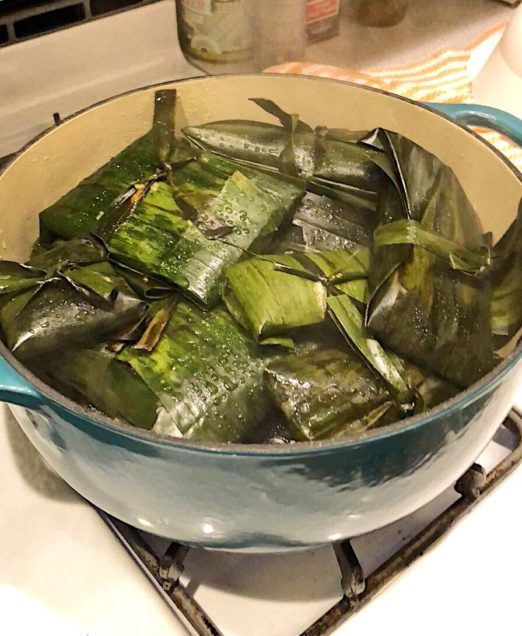Recreating the Taste of Mexico in a Crowded Cambridge Kitchen
Students in Dr. Karen Metheny’s Summer Term course, Anthropology of Food (MET ML 641) are contributing guest posts this month. Today’s post is from Sam Dolph.
In April, my partner and I decided to finally take the frozen banana leaves out of our freezer—purchased many months before —and to dedicate a whole day to making “authentic” Mexican tamales. Having moved to the U.S. three years ago, my partner, who is from Mexico, is very understandably unsatisfied with the Mexican food here in Boston. Anywhere that puts rice inside of a burrito is a mockery of her cuisine, not leaving many options available. Thus, her cravings for Mexican food—tacos, chilaquiles, mole—are only truly satisfied when she makes the dishes herself. So, knowing the labor-intensive process that lay ahead, we made a list of the ingredients we needed and set out to recreate one of her most beloved meals.
Making the tamales was not as easy as finding the ingredients, which we secured at Market Basket and La Internacional Foods, a small Latin American market, both in Somerville. In addition to the banana leaves, we needed achiote paste, salsa ingredients, chicken, and masa dough. After purchasing all of the ingredients, we came home and immediately blended up the salsa ingredients, which we threw into the slow cooker with the chicken and achiote paste. Next, we made the masa dough, which just meant adding the right amount of water, lime juice, and salt to the flour. Despite following a recipe, our proportions were off so we ended up having to add more of everything until we reached the desired consistency.
We then prepared the banana leaves, which was the most difficult part of the process. Banana leaves must be cleaned well before cooking, but they are so delicate that one must clean them very slowly and carefully. We soaked them in water and then softly scrubbed each leaf with a sponge before laying them to air dry. Afterwards, we had to gently rub each leaf with a paper towel to ensure total dryness. We then had to carefully cut the damaged edges of the leaf and then snip them further so they were the correct size. Because the leaves are so fragile, all cuts must be made slowly and deliberately or the entire leaf could be ruined (which we did, multiple times). Needless to say, the banana leaf process lasted the entire four hours.
Finally, it was time to put the tamales together. We first had to warm the clean banana leaves straight on the burner so they could soften, and then we added a layer of masa dough, followed by a layer of the slow cooked chicken, which was then covered by another layer of masa dough. We carefully wrapped the rest of the banana leaves around the chicken-filled dough, and tied each tamale together with a thin string of banana leaf we had cut from the ends of the bigger leaves. We then piled all the tamales into a steamer basket and steamed them for one hour. Altogether, the cooking process lasted around 6 hours. By the time we pulled the tamales out of the steamer, we were starving, cranky, and tired.
Could we have just bought a package of frozen tamales from Trader Joe’s instead, which would’ve taken 30 minutes at most? Maybe. But this wouldn’t have truly satisfied my partner’s craving for Mexican food. The 6-hour process of making tamales meant connecting with her culture as a whole, rather than simply eating it. Filling our bellies with tamales was an added bonus (they were, obviously, delicious), but this entire process was more of an exercise in finding home through food and affirming her Mexican identity in a new setting, than it was about simply eating tamales.